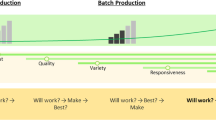Abstract
Unreliability will be a major issue for computers built from components at nanometer scales. Thus, it’s to be expected that such computers will need a high degree of defect-tolerance to overcome components’ defects which have arisen during the process of manufacturing. This paper presents a novel approach to defect-tolerance that is especially geared towards nanocomputers based on asynchronous cellular automata. According to this approach, defective cells are detected and isolated by small configurations that move around randomly in cellular space. These configurations, called random flies, will attach to configurations that are static, which is typical for configurations that contain defective cells. On the other hand, dynamic configurations, like those that conduct computations, will not be isolated from the rest of the cellular space by the random flies, and will be able to continue their operations unaffectedly.
Similar content being viewed by others
References
Durbeck L J K, Macias N J. The cell matrix: an architecture for nanocomputing. Nanotechnology, 2001, 12(3): 217–230
Peper F, Lee J, Abo F, et al. Fault-tolerance in nanocomputers: a cellular array approach. IEEE Transaction on Nanotechnology, 2004, 3(1): 187–201
Peper F, Lee J, Adachi S, et al. Laying out circuits on asynchronous cellular arrays: a step towards feasible nanocomputers? Nanotechnology, 2003, 14(4): 469–485
Heath J R, Kuekes P J, Snider G S, et al. A defect-tolerant computer architecture: opportunities for nanotechnology. Science, 1998, 280: 1716–1721
Isokawa T, Kowawa S, Takada Y, et al. Defect-tolerance in cellular nanocomputers. New Generation Computing, 2007, 25(2): 171–199
Mange D, Sipper M, Marchal P. Embryonic electronics. BioSystems, 1999, 51(3): 145–152
Stauffer A, Mange D, Tempesti G, et al. A self-repairing and self-healing electronic watch: the biowatch. In: Proceedings of the 4th International Conference on Evolvable Systems: From Biology to Hardware (ICES2001). Tokyo: Lecture Notes In Computer Science, 2001, 2210: 112–127
Bradley D, Ortega-Sanchez C, Tyrrell A. Embryonics + immunotronics: a bio-inspired approach to fault tolerance. In: Proceedings of The Second NASA/DoD workshop on Evolvable Hardware. Palo Alto: IEEE Computer Society, 2000, 205–224
Canham R O, Tyrrell A M. A multi-layered immune system for hardware fault tolerance within an embryonic array. In: Proceedings of the 1st International Conference on Artificial Immune Systems. Canterbury: University of Kent at Canterbury, 2002, 3–11
Priese L. Automata and concurrency. Theoretical Computer Science, 1983, 25: 221–265
Hauck S. Asynchronous design methodologies: an overview. Proceedings of the IEEE, 1995, 83(1): 69–93
Isokawa T, Kowada S, Peper F, et al. Online marking of defective cells by random flies. In: the 7th International Conference on Cellular Automata for Research and Industry (ACRI 2006). Perpignan: Lecture Notes In Computer Science, 2006, 4173: 347–356
Peper F, Isokawa T, Kouda N, et al. Self-timed cellular automata and their computational ability. Future Generation Computer Systems, 2002, 18(7): 893–904
Lee J, Peper F, Adachi S, et al. Reversible computation in asynchronous cellular automata. In: Calude C S, Dinneen M J, Peper F, eds. The 3rd International Conference on Unconventional Models of Computation 2002. Kobe: Springer, 2002, 220–229
Ueno R. Universal reversible logic elements with 3 inputs, 3 outputs and 2 states. Dissertation for the Master Degree. Hiroshima University. Hiroshima: Hiroshima University, 2006(in Japanese)
Carmona J, Cartadella J, Takada Y, et al. Formal methods to analyze nanometer scale cellular array. Submitted in June 2007
Author information
Authors and Affiliations
Corresponding author
Rights and permissions
About this article
Cite this article
Isokawa, T., Kowada, S., Peper, F. et al. Online isolation of defects in cellular nanocomputers. Front. Comput. Sc. China 1, 397–406 (2007). https://doi.org/10.1007/s11704-007-0038-8
Received:
Accepted:
Issue Date:
DOI: https://doi.org/10.1007/s11704-007-0038-8




